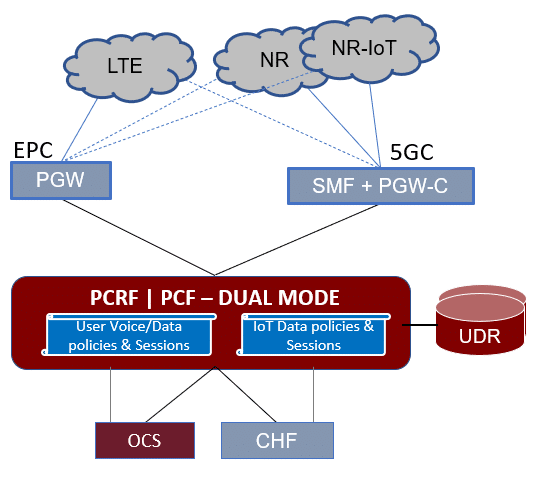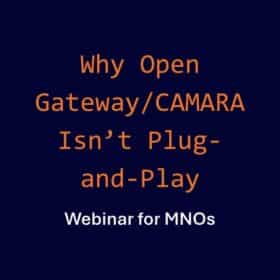Why dual-mode charging policies are key to maximizing 5G monetization
Operators are asking for trouble by not scrutinizing the challenges of running parallel policy functions with separate quota buckets for 4G and 5G, as most will find themselves doing sooner or later. Increased costs; lost monetization opportunities, and lost subscribers can all be the results of poorly aligned policy functions. But choosing not to add 5G core functionality is not an option, at least not for operators who want to unlock new growth opportunities. The challenge for network operators is also compounded by the transformation moves to cloud environments and to scale up policy and usage monitoring for IoT devices, as each user requires 2 policy sessions and each active IoT device at least 1 for data. The diversity of use cases involved also means new, easy to use policy creation and management services are needed.
The good thing is that it can be fixed with dual-mode policy; that is designed to scale, distribute and diversify policy. In order to understand this a little better, it is worth looking at the components involved to this critical function.

The PCF – vital to charging and Monetizing
The PCF is the 5GC function that categorizes, defines, and applies the rules for resource allocation and consumption across devices. It’s what allows operators to govern their network resources and control how they’re used – and crucially, how they’re billed and monetized. The role of the PCF is getting more complex, thanks to the rollout of 5G and the level of insight now available to, and required by, operators. New data sources and traffic patterns mean that operators need far better insight into consumer behaviour, and they want to introduce more contextualized offerings to cater to that behaviour or begin to use machine learning to automate.
That means 5G policy and charging functions also need to evolve, it’s simply not sufficient to bolt-on 5G to an aging 4G Policy (PCRF) environment.
The PCF, which governs 5G resource allocation, is an extension of the 4G policy and charging rules function (PCRF) but adds focus on things like flexible mobility rules and network slicing. These two functions operate on completely separate architectural planes, and 4G’s PCRF was never really designed to work in 5G’s cloud-native environment.
This matters for integration, as we will discuss by example but also because of scale. Introducing a larger number of IoT devices to this environment will also mean that the policy solution requires to handle many more sessions simultaneously and significantly increase the number of policies, 4X, from a few hundred that may be in place today.
The switch from 4G to 5G isn’t a leap, but a steady climb
The rollout of 5G has been gradual. As a result, mobile operators have a subscriber base that frequently switches between 4G and 5G coverage, depending on where they are or what services they’re trying to access. Most deployed 5G networks are still non-standalone (5G NSA), relying on EPC for core functionality with PCRF for policy. As more and more operators add 5GC capabilities to their networks, they will effectively run two separate control functions – the PCRF for EPC and the PCF for 5GC – both with their own quota management.
There are plenty of challenging situations operators put themselves and their subscribers in when running separate quota management systems for 4G and 5G. Just imagine a simple example of a subscriber with two separate quotas. How will one granted quota be managed by two separate systems? Will the subscriber get two text messages with warnings when the quota is nearly used up? And what will be shown in a self-service portal, the remaining data for both quotas?
It may seem like a trivial example, but policy rules are typically very complex, and the efforts to align two policy functions should not be underestimated. Operators miss revenue because quota buckets aren’t correctly aligned, they end up with angry subscribers who get their service denied despite paying for it and having plenty of their data allowance remaining, and they miss monetization opportunities because the disparate systems simply cannot support new use cases. That’s not to mention the increased running costs of maintaining two separate systems and trying to keep them synchronized with one another. Any operator trying to use separate quota buckets for 4G and 5G for the same set of subscribers will not survive long-term.
While both PCRF and PCF can perform usage monitoring and allow for multiple charging functionalities, the next-generation PCF is capable of governing network resources in entirely new ways, taking full advantage of the cloud-native, microservice-based architecture that 5GC allows.
The challenge now facing mobile operators is how to align these two policy control systems together in a way that allows them to fully leverage the monetization opportunities of 5G while still maintaining a common data layer. When not done correctly, operators end up with duplicated costs, duplicated data stores, and finding themselves in a situation where a quota is being used in one place and incorrectly debited in another. In other words, it can form a monetization gap where the engine of the business – the charging model – isn’t performing as well as it could.
The role of dual-mode charging policies
4G isn’t going anywhere yet, so instead of replacing their policy control function outright, operators need to find a way to align PCF and PCRF through a single source of subscriber data for shared quota buckets. Essentially, operators need to look at dual-mode policy, integrating PCRF and PCF into the 5G UDR as the only future-proof option.
Enea’s network functions:
Data Management Applications: Policy

